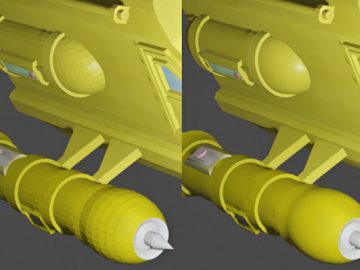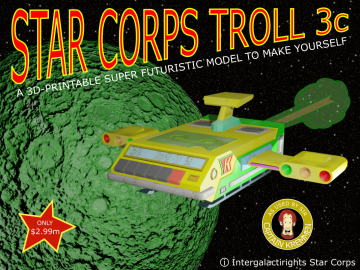Lickey is a lovely little village atop Lickey Hills, south of Birmingham in England. It has some wonderful old features, including the nearby Sixth Earl of Plymouth Monument, which I’ve had the fun of 3D scanning and modelling. But perhaps the most exciting old object there is the Edwardian water fountain and trough built to sustain travellers (and their animals) on their journeys in the days before modern vehicles emerged. Given the size, a 3D scan of the structure wouldn’t have been possible with my basic scanning equipment. However, that wasn’t something to put me off, so I decided to recreate it digitally through 3D modelling, with 3D scanning providing a way to add in the carved details.
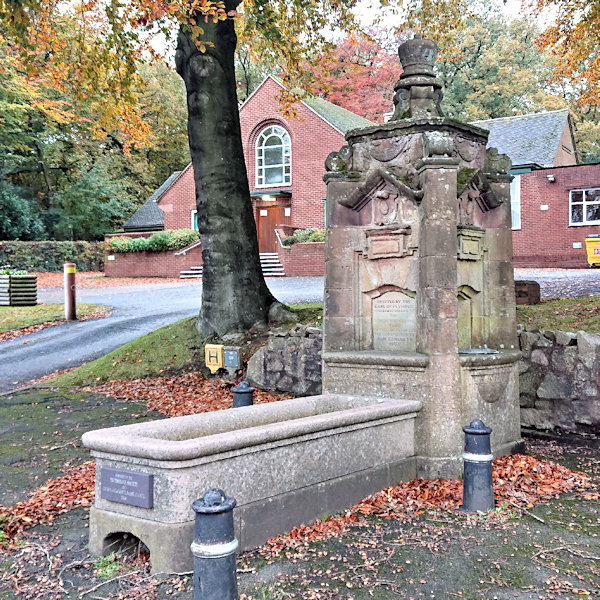
Quick summary of this 3D creation
Overview: A 3D recreation of the old water fountain and drinking trough in Lickey.
Location: Lickey, central England, United Kingdom [map].
Date/era: Reign of Edward VII, 1902.
Software used: LibreCAD, OpenSCAD, Blender, Meshmixer, Nomad Sculpt Android app.
Intended use: 3D printing with resin or fused filament printers, although the level of detail, and need for support material if fused-filament printing, mean that resin printing would be preferable.
According to the inscriptions this water fountain and trough was built in 1906, during the reign of King Edward VII, and was ‘Erected by the Earl of Plymouth and subscribers to the North Worcester Fund raised to celebrate the coronation of King Edward VII 1902‘. The inscription on the plaque at the end of the trough also says it was ‘Restored by the Bromsgrove Society and Lickey and Blackwell Parish Council 2006‘.
The main water fountain structure was modelled using OpenSCAD based on measurements taken on-site using a Bosch Bluetooth LASER-measure. Some areas, such as the insets and sink surrounds, were a little complicated for constructing from 3D primitives. Therefore they were built by drawing 2D cross-sections in LibreCAD, and extruding them in OpenSCAD for adding to, or subtracting from, the rest of the model. The resulting model was then imported into Blender where the trough was modelled to the measured dimensions. The carvings were then added from 3D scans pre-processed in Meshmixer. The combined model was then solidified using Nomad Sculpt on Android, as a test of its voxel-remeshing, which turned out very well. All 3D scanning was done using the excellent Sony 3DCreator app on an Xperia XZ2 smartphone. You can see the finished model on Sketchfab below (click the play button to load the model and view it in 3D).
The 3D prints in the photo below were made using a Monoprice Mini SLA printer with standard UV-cured resin. Resin prints are generally printed at an angle, to reduce suction at each layer when pulling them away from the base of the resin vat. However, as you can see in the photo, I printed the model at 90 degrees to the build plate, the only supports being between the model and the raft. That meant that there were no supports that could annoyingly mar the fine details, which would have been tiresome to remove fully. However, I did hollow the model in Meshmixer before printing, with a drainage hole in the base, which helped reduce the additional suction the right-angle printing could cause. The model should also print acceptably on a fused filament printer, but the need for support in some areas, and the small details in other areas, make resin printing the best option. If you want to try 3D printing it yourself, click here to go to the MyMiniFactory page to download it.
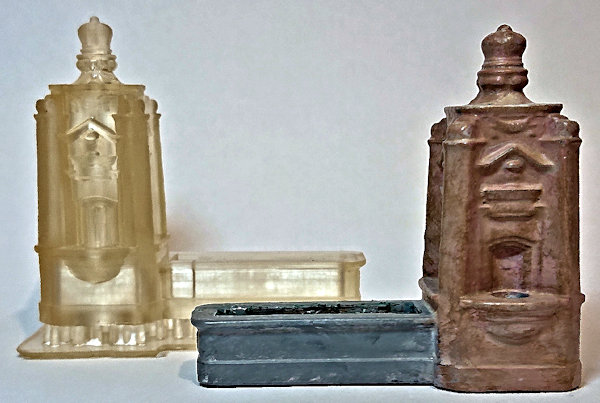
The print on the right of the photo was then painted using Pebeo craft acrylics and a coat of anti-shine varnish. I wasn’t really looking for a very detailed finish, or even a very convincing stone effect, but I didn’t feel the outcome was what I wanted as a 3D printed model to display on a shelf. So even though the craft acrylic painting wasn’t really too bad, I decided that I could make a better version after discovering The Army Painter paints and their wash medium. So I decided to try them out on a mini diorama with a very simple base printed in PLA, designed from primitives in OpenSCAD and printed on a Flashforge Adventurer 3C printer using their own filament. You can see the result in the photo below.
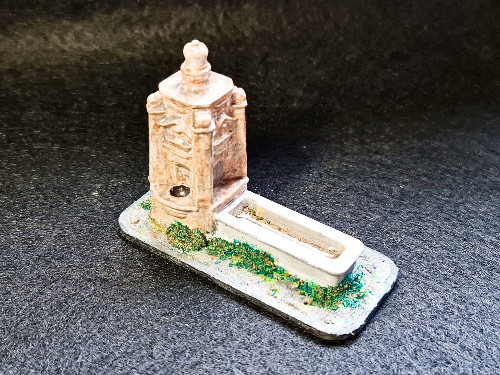
I think I can definitely say that I was quite pleased with the finished look. Probably that’s partly because I added some fine sand to the base for a macadam effect, as well as some model railway scatter grass to emulate wind-blown leaves, both simply stuck down with gel super glue. I also added some Pebeo glazing resin to the bottom inside the trough, so that from a distance it looks a bit like it’s filled with water.
So finally, in case you’d like to use the methods in this project for your own work, let’s recap on what was involved:
- Key dimensions were measured using a Bosch bluetooth-enabled LASER distance meter and the Android ImageMeter app.
- The tall water fountain part was created in OpenSCAD based on constructive solid geometry (CSG) using primitives scaled using the measurements.
- More complex geometry in the water fountain (e.g. the sink areas and insets) was created in OpenSCAD by extruding cross-sections drawn in 2D in LibreCAD, for adding or removing using CSG.
- The water fountain was then exported into Blender, where the water trough part was modelled from a union of solids and the edges rounded, based on the measurements.
- Nomad Sculpt was then used to combine the water fountain, the water trough, and the scans of the carving.
- The finished 3D model was then test printed in resin and found to print to an acceptable quality.
- Although the model could be printed with a fused-filament 3D printer, the details and overhangs mean that a good print is much more likely when made in resin.
Some useful links
For more information about Lickey Hills please feel free to follow the links below:
Bromsgrove Society: http://bsoc.co.uk
Lickey and Blackwell Parish Council: https://www.lickeyandblackwellpc.org
Please note that this model is provided without any license for commercial use. It is intended simply as a historical model you can have the fun of printing yourself that advertises this beautiful old structure. And of course it is intended to be a motivation for you to visit Lickey yourself and, while looking around this beautiful village, stop to take in the wonder of this structure from a bygone age when travelling by foot or horse was the main way to get around: click here to see the location in Google Maps.


